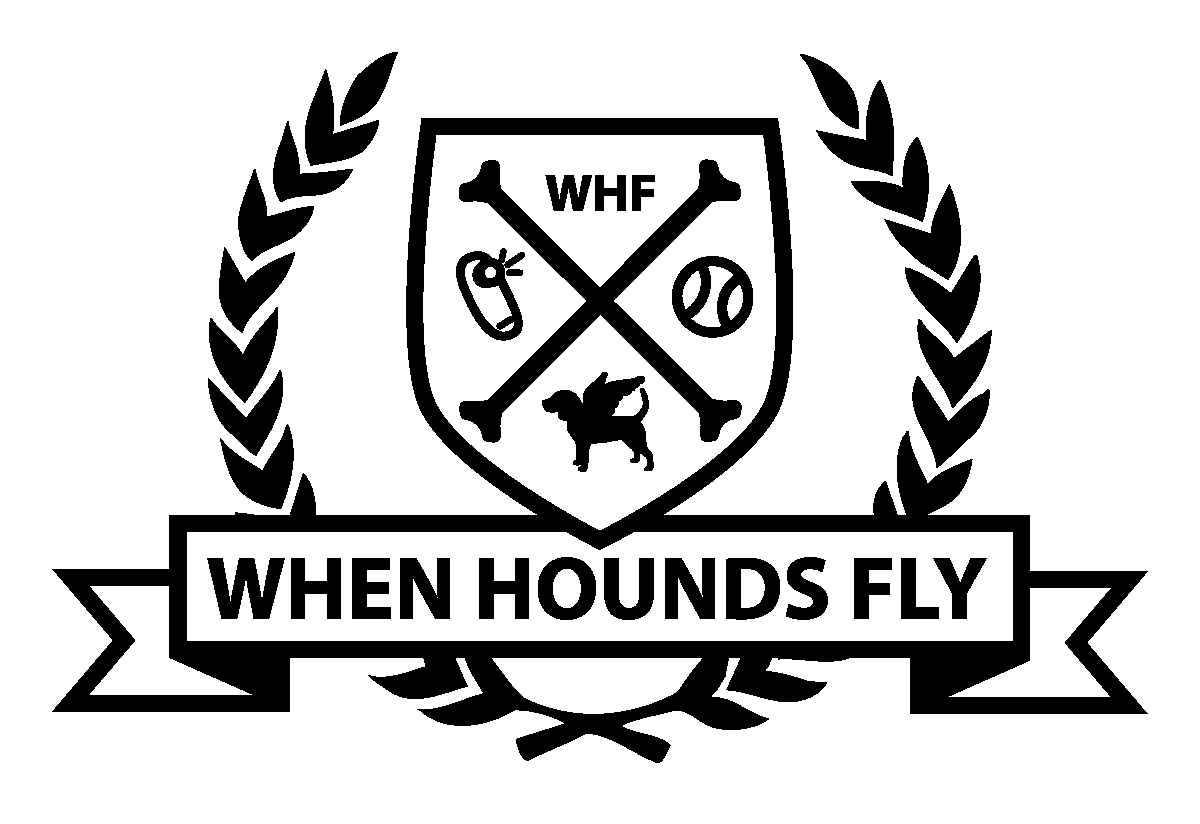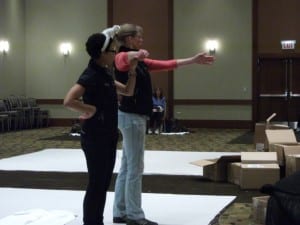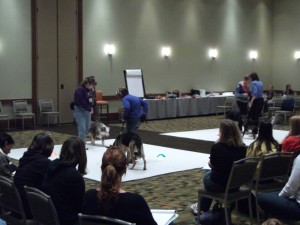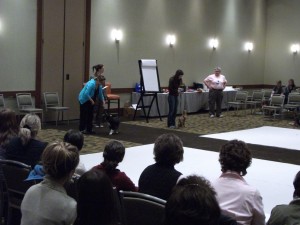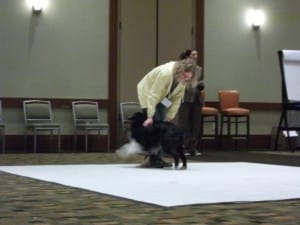I’m exhausted! I feel like I’m back in school… also feeling a bit inadequate, but also really fired up about enhancing my own training skills as soon as I get back home. Cecilie said during her lecture today “You could shape that way forever and be perfectly fine, but doing it this way will make your training more efficient.” Who doesn’t want to be more efficient? So here’s a summary of what I did and what I learned.
Session 1: Shaping Procedures for the Agility Trainer (Eva Bertilsson and Emelie Johnson Vegh)
I’m not an agility trainer and I don’t know the first thing about agility. This is exactly why I took their track.
The most important concept they shared today is the concept that shaping is not just Behavior, Click, Reward, repeat. There is a TON of behavior that occurs between the taking of the reward and the next cue. What happens here MATTERS. If you don’t pay attention to what occurs after the dog eats their treat and the next behavior, you end up building a lot of “garbage behaviors” in your training.
A perfect example I have from my own training is with Petey. He often throws in extra behaviors between reps – a common one I see is he spins clockwise between behaviors. Another common example I see with many dogs is during a Watch Me exercise – after the dog eats their treat, they often start scanning the room and looking at other dogs.
In both cases, the eating of the treat has become a cue to do an extra behavior. If we are trying to build focus in the Watch Me, and you continue to allow your dog to eat, then scan, then cue Watch me, then click, eat, and scan, you are actually reinforcing scanning/looking away.
Good training eliminates the garbage that happens between repetitions. You can manipulate the environment to prevent those extra behaviors, change criteria/increase rate of reinforcement, or work on reinforcement delivery (position) to prevent garbage behaviors from occuring.
Garbage behaviors are also contextual. In obedience, a great behavior to get after eating a treat is for the dog to look back at the handler, since we are trying to build extreme focus on the handler. But in agility, we are trying to have the dog continue along the intended path of the course (criteria would be nose ahead towards line).
Session 2: Shaping Procedures for the Agility Trainer in Action
This was my first Learning Lab for ClickerExpo. Since I am without a dog, I attended as an observer.
The primary exercises for the dogs in this lab was to implement the “Aim for It” procedure – which in a nutshell, is nose ahead towards intended path. These exercises were fantastic, however, what really blew my mind was the exercises that preceeded Aim for It.
Eva and Emelie actually spent a good thirty minutes simply working on the protocols that lead UP to beginning training. This is what happens before you start training with your dog. It is clear that what happens in between training sessions is key to making each training session impactful, an also getting maximum intensity and the right attitude out of the dog.
Training starts with a dog at their “Station”. The station can be a mat or a crate. When a dog is at their station, the dog is off-duty and the handler is free to think, plan, and prepare. Once the trainer is ready, the dog is moved from their station to their work area through a “Transport”.
Transport, as they define it, is not just walking the dog casually on leash (or off) to their working area. When transporting a dog, they assert that the handler must be fully engaged and contacting their dog at all times. That can mean dog is being lured/lead with food from your hand (and making full contact/munching away), lead with a collar grab, or lead via a tug toy.
As soon as the trainer disengages with your dog (food hand is taken away, hand goes off collar, or toy is taken away), training starts, and you c/t the first behavior that meets criteria (for Aim for It, it’s nose ahead). Once the trainer is done the session, he immediately go back to transporting (by using your last food reward as a lure back to the station, or tugging back, or collar grabbing and leading back).
This protocol takes “pay attention to your dog” to a whole new level for me and I feel quite guilty for leaving my dogs “dangling” after the end of a training session now.
Session 3: Efficient Training – Making Progress Quickly (Cecilie Køste)
This session had a lot of parallels to Eva and Emelie’s. A lot of it covered basic good training form (no talking while training, hands by the side (not in the bait bag), etc. She also spent a lot of time sharing videos of her colleagues training, and they do also have very regimented stations – the dog was sent to his crate whenever the trainer needed a break, or time to setup the training environment (moving props, reloading treats, packing tug toys, etc.)
The biggest takeaway I got from her presentation was placement of reward. As I mentioned earlier, up to this point I have been pretty relaxed about treat placement. Primarily, I used treat placement as a way to reset the dog to maximize the # of behavior repetitions in a training session (i.e. click for watch, toss treat for to floor to reset, or click for down, toss treat to side to reset, or click for mat, toss treat away so the dog has to travel back to the mat). She summarized the four different strategies for treat placement as follows:
- Reinforce in position (treat in down for down stay – room service as she calls it)
- Reinforce to reset position (to expedite the next repetition)
- Reinforce for Direction Sliding (treat ahead of the dog away from you in heel to counter-act the tendency for a dog to become banana shaped in heeling)
- Reinforce to next behavior in behavior chain (toss toy over jump, if final behavior in chain is a jump
Session 4: Click to Calm Unleashed with Emma Parsons
Last lab of the day – I was an observer in Emma Parsons’ Click to Calm Unleashed lab. She ran the lab walking through the different exercises she teaches in her Click to Calm class for reactive dogs. What’s amazing about them is they don’t actually require a ton of space, and one thing that was really surprising is how hard she pushes her students… making trainers with their space sensitive dogs work in extremely close proximity by being strategic and careful about entrances, exits, and maintaining high rate of reinforcements (or sometimes just shoveling food into the dog’s mouth). With more research and planning hopefully I can incorporate some of these exercises for classes at When Hounds Fly.
The evening ended off with dinner with a lecture by Patricia McConnell – I’ll write more about that tomorrow.
Have a good night!
